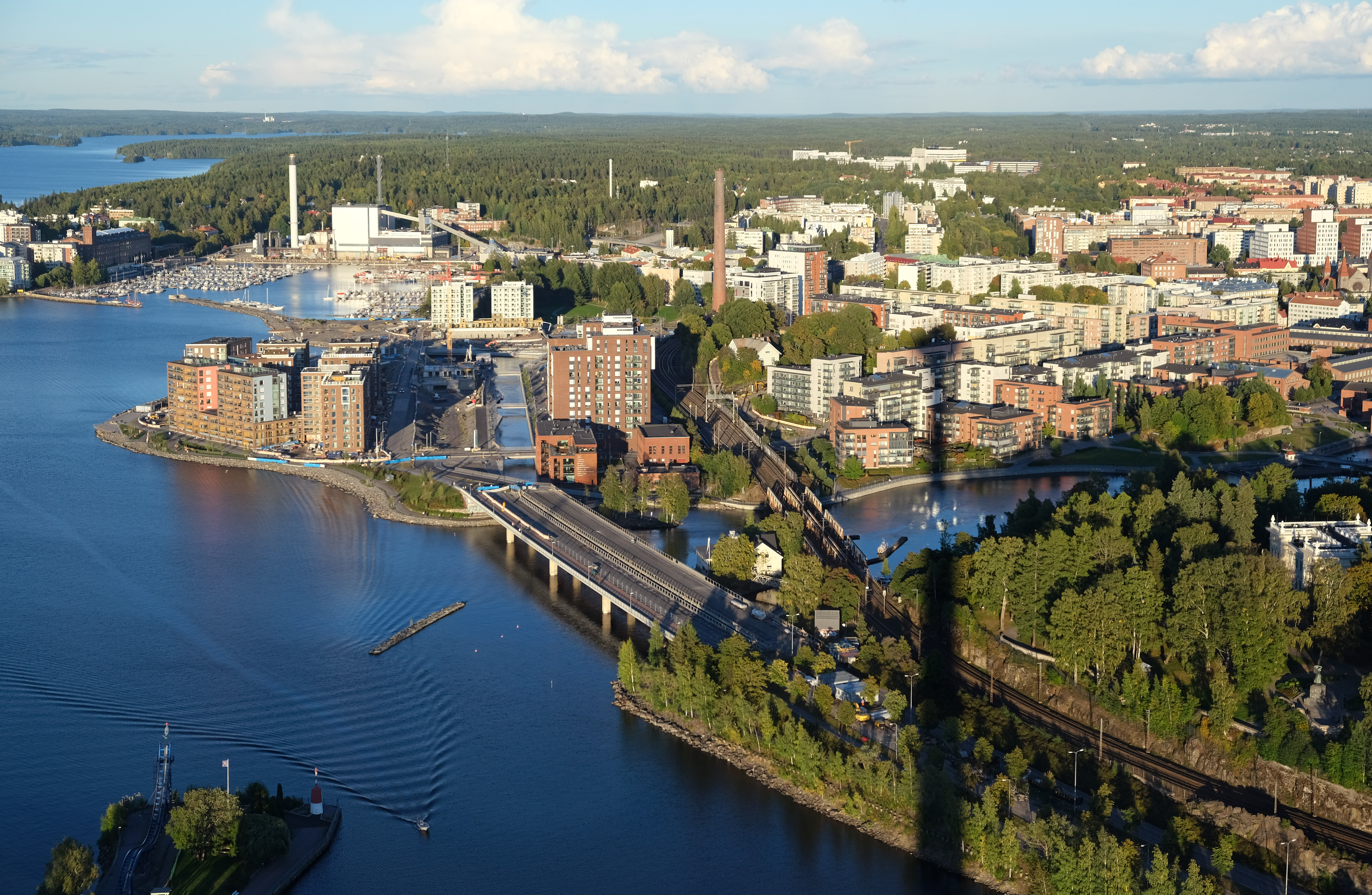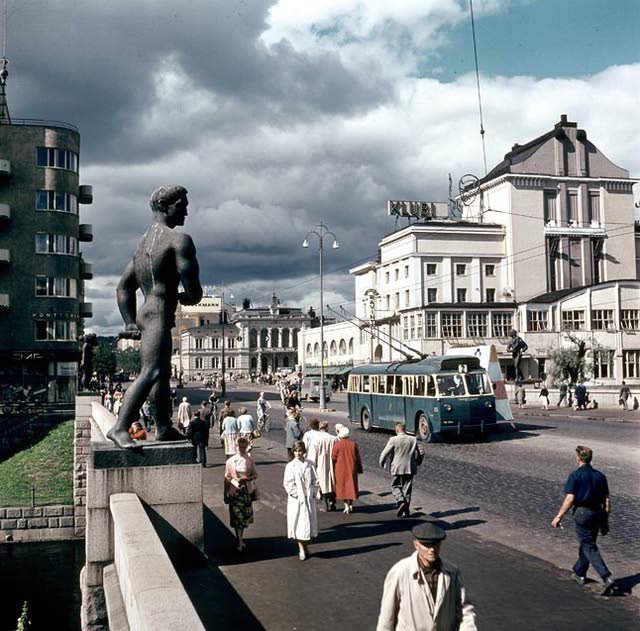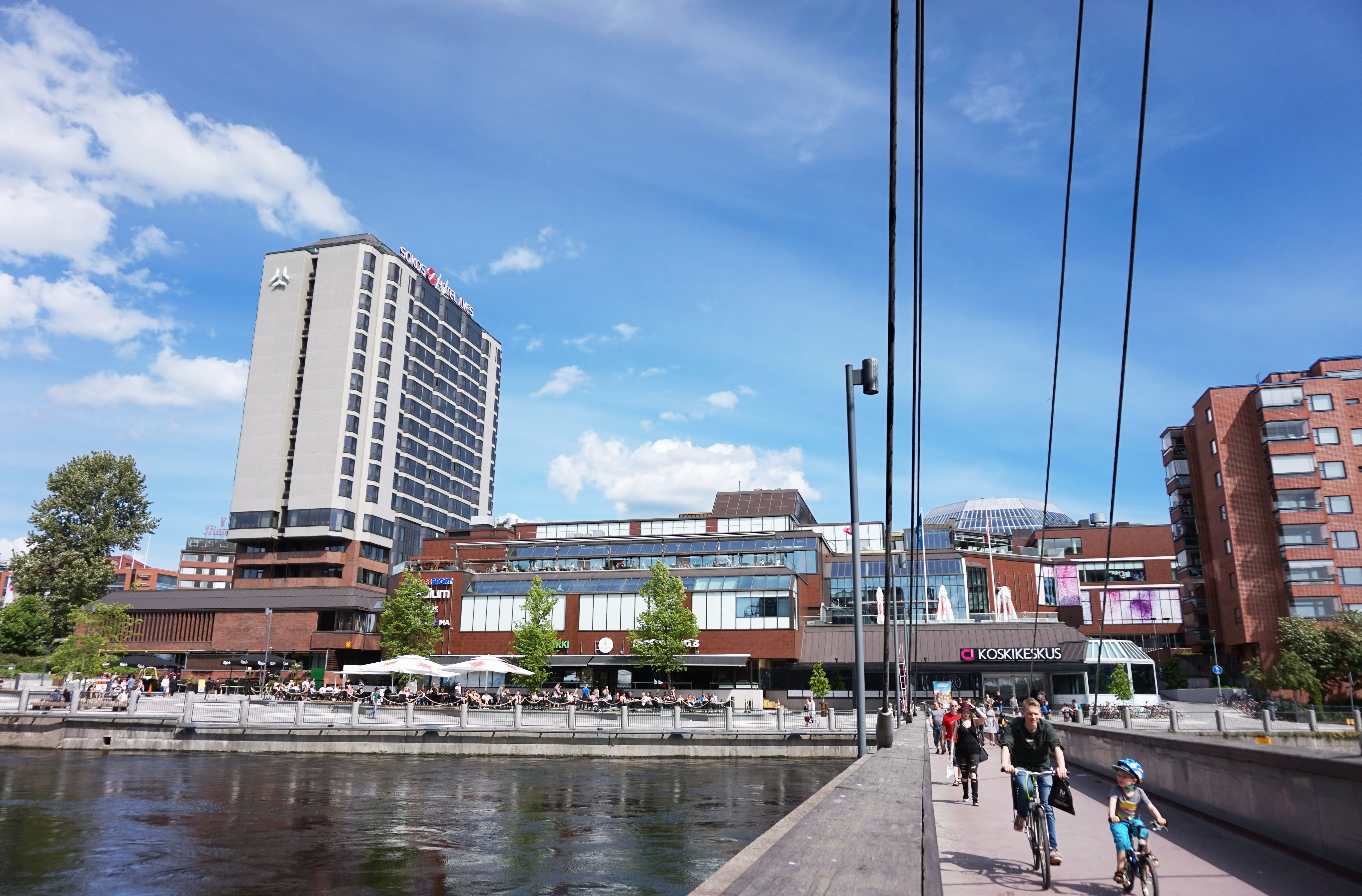|
Satakunnansilta
Satakunnansilta (the ″Satakunta Bridge″) is an old bridge in Tampere, Finland, that crosses the Tammerkoski rapids north of Hämeensilta. The bridge is part of the Satakunnankatu street and is used by both vehicle traffic and pedestrians. The Satakunta Bridge was designed by engineer Karl Snellman, son of Senator J. V. Snellman. It was built between 1897 and 1900 and commissioned on October 9, 1900. The bridge is a 6-span stone arch bridge An arch bridge is a bridge with abutments at each end shaped as a curved arch. Arch bridges work by transferring the weight of the bridge and its loads partially into a horizontal thrust restrained by the abutments at either side. A viaduct ... with spans of 17 meters. The width of the bridge is 11.75 meters and its total length is 112.6 meters. In 2013, the bridge railings were refurbished to the original model, and in 2014, the bridge lamps were replaced with the original model. References External links Satakunnansilt ... [...More Info...] [...Related Items...] OR: [Wikipedia] [Google] [Baidu] |
Tammerkoski
Tammerkoski is a channel of rapids in Tampere, Finland. The city of Tampere is located between two lakes, Näsijärvi and Pyhäjärvi. The difference in altitude between these two is and the water flows from Näsijärvi to Pyhäjärvi through the Tammerkoski rapids. The banks of the Tammerkoski are among the oldest industrial areas in Finland. There was a busy marketplace in the 17th century. Tampere was founded on the banks of the rapids, as the rushing water provided a great deal of power for the needs of industry. There are four power stations and three dams located on the Tammerkoski. The highest in altitude is the dam between Finlayson and Tampella. From this dam, the stream is led to the power stations of Finlayson and Tampella on either side of the rapids. In the middle, there is the city's power plant and the lowest one in terms of altitude is the dam at the Tako paperboard mill, which belongs to M-real. The three uppermost power stations are owned by the city, whil ... [...More Info...] [...Related Items...] OR: [Wikipedia] [Google] [Baidu] |
Hämeensilta
Hämeensilta (the ″Häme Bridge″) is a bridge in Tampere, Finland, crossing the Tammerkoski rapids. The main street of Tampere, Hämeenkatu, runs along the bridge, connecting the Kyttälä district to the western parts of the city center. Hämeensilta is one of the city's best known landmarks, especially famous for the statues on the rails of the bridge. The arches of the bridge are made of concrete and they are coated with a red granite. The Hämeensilta was completed in 1929. It is named after the Finnish name of the Tavastia province. History The first known bridge crossing the Tammerkoski was built in the 16th century as the area was a part of the Messukylä socken. As the town of Tampere was established in 1779, the wooden bridge was finally replaced with a steel structured in 1884. During the early 1900s, Tampere was rapidly growing and the present Hämeensilta was built in 1928–1929. The 1900 completed Satakunnansilta is the other large bridge crossing Tammerkosk ... [...More Info...] [...Related Items...] OR: [Wikipedia] [Google] [Baidu] |
Satakunnankatu
Satakunnankatu is an east–west, busy street in the center of Tampere, Finland, which is one of the city's main streets. It starts from the vicinity of Tampere Cathedral on the east side of Tammerkoski, where it separates the Jussinkylä and Kyttälä Districts. The street crosses the rapids along the Satakunta Bridge (''Satakunnansilta'') and runs on the west side between Finlayson and the Hämeenpuisto park. From there it continues through the Amuri area to the Pirkankatu street. Satakunnankatu is part of the nationally significant industrial landscape of Tammerkoski, and there are several sites along it that are valuable for architecture, cultural history and the cityscape. The street is bordered by, among other things, the former weaving building Plevna (1877), which belongs to the Finlayson factory area, where the first electric lighting in the Nordic countries and the then Russian Empire was introduced in 1882. Other nationally significant buildings on Satakunnank ... [...More Info...] [...Related Items...] OR: [Wikipedia] [Google] [Baidu] |
Tampere
Tampere ( , , ; sv, Tammerfors, ) is a city in the Pirkanmaa region, located in the western part of Finland. Tampere is the most populous inland city in the Nordic countries. It has a population of 244,029; the urban area has a population of 341,696; and the metropolitan area, also known as the Tampere sub-region, has a population of 393,941 in an area of . Tampere is the second-largest urban area and third most-populous individual municipality in Finland, after the cities of Helsinki and Espoo, and the most populous Finnish city outside the Greater Helsinki area. Today, Tampere is one of the major urban, economic, and cultural hubs in the whole inland region. Tampere and its environs belong to the historical province of Satakunta. The area belonged to the Häme Province from 1831 to 1997, and over time it has often been considered to belong to Tavastia as a province. For example, in '' Uusi tietosanakirja'' published in the 1960s, the Tampere sub-region is presented as p ... [...More Info...] [...Related Items...] OR: [Wikipedia] [Google] [Baidu] |
Arch Bridge
An arch bridge is a bridge with abutments at each end shaped as a curved arch. Arch bridges work by transferring the weight of the bridge and its loads partially into a horizontal thrust restrained by the abutments at either side. A viaduct (a long bridge) may be made from a series of arches, although other more economical structures are typically used today. History Possibly the oldest existing arch bridge is the Mycenaean Arkadiko Bridge in Greece from about 1300 BC. The stone corbel arch bridge is still used by the local populace. The well-preserved Hellenistic Eleutherna Bridge has a triangular corbel arch. The 4th century BC Rhodes Footbridge rests on an early voussoir arch. Although true arches were already known by the Etruscans and ancient Greeks, the Romans were – as with the vault and the dome – the first to fully realize the potential of arches for bridge construction. A list of Roman bridges compiled by the engineer Colin O'Connor featur ... [...More Info...] [...Related Items...] OR: [Wikipedia] [Google] [Baidu] |
Kyttälä
Kyttälä is a district in Tampere, Finland. It was born in the late 1870s as a working-class neighborhood to the eastern outskirts of the town. As Tampere soon expanded, Kyttälä is now a part of the city center between the Tammerkoski river and the railway. Population of Kyttälä is 3,348 (31 December 2014). Aleksanterinkatu (Tampere), Aleksanterinkatu is one of Kyttälä's main streets. The direct connection to the Liisankallio, Liisankallio district and from there to Teiskontie and Sammonkatu streets runs along Itsenäisyydenkatu and connection to the Jussinkylä, Jussinkylä district runs along Tuomiokirkonkatu. Notable sights *Tampere Orthodox Church *Hotel Tammer *Tampere railway station *Hotel Ilves *Koskikeskus (shopping centre) *Posteljooninpuisto *Sori Square See also * Ratina (district) * Tulli (district) References [...More Info...] [...Related Items...] OR: [Wikipedia] [Google] [Baidu] |
Buildings And Structures In Tampere
A building, or edifice, is an enclosed structure with a roof and walls standing more or less permanently in one place, such as a house or factory (although there's also portable buildings). Buildings come in a variety of sizes, shapes, and functions, and have been adapted throughout history for a wide number of factors, from building materials available, to weather conditions, land prices, ground conditions, specific uses, prestige, and aesthetic reasons. To better understand the term ''building'' compare the list of nonbuilding structures. Buildings serve several societal needs – primarily as shelter from weather, security, living space, privacy, to store belongings, and to comfortably live and work. A building as a shelter represents a physical division of the human habitat (a place of comfort and safety) and the ''outside'' (a place that at times may be harsh and harmful). Ever since the first cave paintings, buildings have also become objects or canvasses of much arti ... [...More Info...] [...Related Items...] OR: [Wikipedia] [Google] [Baidu] |
Bridges In Finland
A bridge is a structure built to span a physical obstacle (such as a body of water, valley, road, or rail) without blocking the way underneath. It is constructed for the purpose of providing passage over the obstacle, which is usually something that is otherwise difficult or impossible to cross. There are many different designs of bridges, each serving a particular purpose and applicable to different situations. Designs of bridges vary depending on factors such as the function of the bridge, the nature of the terrain where the bridge is constructed and anchored, and the material used to make it, and the funds available to build it. The earliest bridges were likely made with fallen trees and stepping stones. The Neolithic people built boardwalk bridges across marshland. The Arkadiko Bridge (dating from the 13th century BC, in the Peloponnese) is one of the oldest arch bridges still in existence and use. Etymology The ''Oxford English Dictionary'' traces the origin of the w ... [...More Info...] [...Related Items...] OR: [Wikipedia] [Google] [Baidu] |
Bridges Completed In 1900
A bridge is a structure built to span a physical obstacle (such as a body of water, valley, road, or rail) without blocking the way underneath. It is constructed for the purpose of providing passage over the obstacle, which is usually something that is otherwise difficult or impossible to cross. There are many different designs of bridges, each serving a particular purpose and applicable to different situations. Designs of bridges vary depending on factors such as the function of the bridge, the nature of the terrain where the bridge is constructed and anchored, and the material used to make it, and the funds available to build it. The earliest bridges were likely made with fallen trees and stepping stones. The Neolithic people built boardwalk bridges across marshland. The Arkadiko Bridge (dating from the 13th century BC, in the Peloponnese) is one of the oldest arch bridges still in existence and use. Etymology The ''Oxford English Dictionary'' traces the origin of the w ... [...More Info...] [...Related Items...] OR: [Wikipedia] [Google] [Baidu] |
Guard Rail
Guard rail, guardrails, or protective guarding, in general, are a boundary feature and may be a means to prevent or deter access to dangerous or off-limits areas while allowing light and visibility in a greater way than a fence. Common shapes are flat, rounded edge, and tubular in horizontal railings, whereas tetraform spear-headed or ball- finialled are most common in vertical railings around homes. Park and garden railings commonly in metalworking feature swirls, leaves, plate metal areas and/or motifs particularly on and beside gates. High security railings (particularly if in flat metal then a type of palisade) may instead feature jagged points and most metals are well-suited to anti-climb paint. A handrail is less restrictive on its own than a guard rail and provides support. Guardrails also apply in a technology context. Public safety Many public spaces are fitted with guard rails as a means of protection against accidental falls. Any abrupt change in e ... [...More Info...] [...Related Items...] OR: [Wikipedia] [Google] [Baidu] |
Pedestrian
A pedestrian is a person traveling on foot, whether walking or running. In modern times, the term usually refers to someone walking on a road or pavement, but this was not the case historically. The meaning of pedestrian is displayed with the morphemes ''ped-'' ('foot') and ''-ian'' ('characteristic of'). This word is derived from the Latin term ''pedester'' ('going on foot') and was first used (in English language) during the 18th century. It was originally used, and can still be used today, as an adjective meaning plain or dull. However, in this article it takes on its noun form and refers to someone who walks. The word pedestrian may have been used in middle French in the Recueil des Croniques et Anchiennes Istories de la Grant Bretaigne, à présent nommé Engleterre. In California the definition of a pedestrian has been broadened to include anyone on any human powered vehicle that is not a bicycle, as well as people operating self-propelled wheelchairs by reason of p ... [...More Info...] [...Related Items...] OR: [Wikipedia] [Google] [Baidu] |
Aamulehti
(Finnish for "morning newspaper") is a Finnish-language daily newspaper published in Tampere, Finland. History and profile ''Aamulehti'' was founded in 1881 to "improve the position of the Finnish people and the Finnish language" during Russia's rule over Finland. The founders were nationalistic Finns in Tampere. During the Cold War period ''Aamulehti'' was among the Finnish newspapers which were accused by the Soviet Union of being the instrument of US propaganda, and the Soviet Embassy in Helsinki frequently protested the editors of the paper. In the 1980s, Aamulehti Corporation acquired the paper '' Uusi Suomi'', which they shut down in 1991. ''Aamulehti'' was published in broadsheet format until April 2014 when the paper switched to tabloid format. Matti Apunen was the editor-in-chief of the paper until 2010. The paper is based in Tampere and serves the Pirkanmaa region. Until 1992 the paper aligned itself with the National Coalition Party, but it no longer has an ... [...More Info...] [...Related Items...] OR: [Wikipedia] [Google] [Baidu] |





